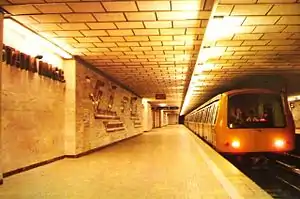Astra IVA
Astra IVA is a family of metro train used by Bucharest Metro, of which 504 cars (252 two-car sets) were built between 1976 and 1993 by Astra Rail Industries in Arad, Romania.
| Astra IVA | |
|---|---|
 Astra IVA unit 003, one of the oldest still in use, at Străulești in 2019. This unit was made in 1978, being the first from the production series. | |
 Interior of an Alstom-refurbished IVA trainset, July 2011 | |
| In service | 1979–present |
| Manufacturer | Întreprinderea de Vagoane Arad (Astra Rail Industries) |
| Constructed | 1976, 1978–1992 |
| Entered service | 16 November 1979 |
| Refurbished | 1994–1996 (FAUR), 2000–2003, 2008 (Alstom), 2011–2014 (Alstom) |
| Scrapped | 2007–present |
| Number built | 504 cars (252 two-car sets) |
| Fleet numbers | 001-252 (001* and 002* prototypes) |
| Capacity | 2 × 166 |
| Operator(s) | Bucharest Metro |
| Depot(s) | Ciurel/Semănătoarea, Pantelimon, Berceni, Militari |
| Line(s) served | Line M3 Line M4 |
| Specifications | |
| Car length | 2 × 19 metres (62 ft 4 in) |
| Width | 310 centimetres (10 ft 2 in) |
| Height | 360 centimetres (11 ft 10 in) |
| Maximum speed | 80 km/h (50 mph) |
| Weight | 2 × 36 t (79,000 lb) |
| Acceleration | 1.3 m/s |
| Electric system(s) | 750 V DC Third rail |
| Current collection method | Contact shoe |
| Safety system(s) | ATP, ATO |
| Track gauge | 1,435 mm (4 ft 8 1⁄2 in) standard gauge |
History

The prototype was made in 1976, with series production starting in 1978. There were three batches, the first being made in 1978-1980 and being distinctive from the others due to a "pit" in the front end, the second one being made between 1980-1985, and the third one made from 1985-1992, featuring red-silver instead of yellow paint from delivery.
The trains used on the system are made up of various trainsets (Ramă Electrică de Metrou) connected together (Tren Electric de Metrou). Each trainset is made up of two permanently connected train-cars (B'B'-B'B' formation) that can only be run together. Normally, 3 two-car sets are coupled together to make a complete six-car formation.
Between 1994 and 1996, 42 cars (21 two-car sets) were refurbished by FAUR and Electroputere for service on Line M3, however for unknown reasons the refurbishment project was abandoned and these trainsets are currently preserved at Berceni Depot. These trains were distinguished by a blue livery, and featured new technical equipment.[1] An attempt to build more intermediate coaches to allow for a 3-car x 2 formation was abandoned in 1995. In 2000–2003, all remaining Astra IVA coaches were refurbished and equipped with new ATO and ATP signalling systems, allowing for partial driverless operation especially on Line M4. The Astra IVA trains also underwent further refurbishment by Alstom in 2008, and again in 2011–2014.
The Astra Arad rolling stock is approaching the end of its service life, so the cars are being gradually phased out in favour of newer Bombardier Movia and CAF trains.[2] As of January 2017, 15 trainsets (90 modular cars) are in commercial service.[3]
In 2020, due to the deployment of several Bombardier BM2 sets on the M5 metro line, several IVA sets were sent back on the M3 line to fill in shortages of rolling stock, their redeployment commencing on 24 May.[4]
Specifications
- Car Builder: ASTRA
- Unit Numbers: 001-252 (001* and 002* prototypes)
- Car Length: 2 × 19,000 mm (748.0 in)
- Car Width: 3,100 mm (122.0 in)
- Car Height: 3,600 mm (141.7 in)
- Track Gauge: 1,435 mm (4 ft 8 1⁄2 in) standard gauge
- Total Weight: 2 × 36,000 kg (79,000 lb)
- Propulsion System: 4 × 215 KW AC Motors
- Power (Third Rail): 750 VDC
- Acceleration: 1.3 m/s2 (4.3 ft/s2)
- Deceleration: 1.3 m/s2 (4.3 ft/s2)
- Emergency Deceleration: 2 m/s2 (6.6 ft/s2)
- Max. Speed: 80 km/h
- Total Seating: 2 × 34
- Normal capacity: 2 × 166
- Coupling/Numbering Arrangement: All married pairs
- Number of cars produced: 2 × 254 (508)
Source: metroubucuresti.webs.com[5]
See also
References
- "Electroputere nu va mai face niciodată locomotive sau vagoane de metrou. Statul vrea fabrica înapoi", Economica.net, retrieved 25 June 2016
- IVA at transira.ro
- În cele mai noi staţii de metrou vor circula cele mai vechi trenuri Metrorex (in Romanian)
- https://www.youtube.com/watch?v=rJEpvN1bfO8
- Bucharest Metro Rolling stock Archived August 9, 2014, at the Wayback Machine
External links
| Wikimedia Commons has media related to Astra IVA. |
- Page on the ASTRA IVA cars (in Romanian)
- ASTRA/IVA (in Romanian)
- ASTRA/IVA modernized by Alstom (in Romanian)